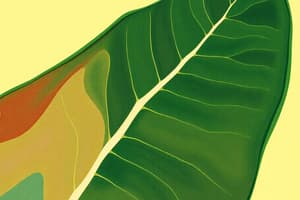Podcast
Questions and Answers
What process causes water to come out of leaves in the form of vapor?
What process causes water to come out of leaves in the form of vapor?
Transpiration
What is the name of the process that makes water drops appear on the polythene cover in the activity?
What is the name of the process that makes water drops appear on the polythene cover in the activity?
Transpiration
Why did the activity involve enclosing a leafy branch in a polythene cover?
Why did the activity involve enclosing a leafy branch in a polythene cover?
To observe water droplets forming on the inner surface of the cover due to transpiration.
What function do leaves serve in plants?
What function do leaves serve in plants?
Name some plants that have reticulate venation and parallel venation on their leaves.
Name some plants that have reticulate venation and parallel venation on their leaves.
What is the significance of observing water droplets on the polythene cover in the activity?
What is the significance of observing water droplets on the polythene cover in the activity?
How many sepals does a flower have?
How many sepals does a flower have?
What is the main function of roots in a plant?
What is the main function of roots in a plant?
Are the sepals joined together?
Are the sepals joined together?
What is the purpose of Activity 6 described in the text?
What is the purpose of Activity 6 described in the text?
What are the colors of the petals and sepals?
What are the colors of the petals and sepals?
How many petals does a flower have?
How many petals does a flower have?
Are the petals joined together or separate?
Are the petals joined together or separate?
What is the outcome of watering plants regularly in Activity 6?
What is the outcome of watering plants regularly in Activity 6?
What are the three main parts of a pistil?
What are the three main parts of a pistil?
Do flowers with joint sepals have petals that are separate or joined together?
Do flowers with joint sepals have petals that are separate or joined together?
What materials are required for Activity 7 mentioned in the text?
What materials are required for Activity 7 mentioned in the text?
What is the significance of keeping the cotton wet in Activity 7?
What is the significance of keeping the cotton wet in Activity 7?
Why is it important for plants to have roots?
Why is it important for plants to have roots?
What is the swollen lowermost part of the pistil called?
What is the swollen lowermost part of the pistil called?
What are the three main parts of a stamen?
What are the three main parts of a stamen?
What is the innermost part of a flower called?
What is the innermost part of a flower called?
What are the two parts of the stamens in a flower?
What are the two parts of the stamens in a flower?
How many stamens are typically found in a flower?
How many stamens are typically found in a flower?
What is the function of a stem?
What is the function of a stem?
Which type of roots do plants with leaves having reticulate venation usually have?
Which type of roots do plants with leaves having reticulate venation usually have?
What are the parts of a flower?
What are the parts of a flower?
Which part of the plant anchors it firmly in the soil?
Which part of the plant anchors it firmly in the soil?
What do green leaves use to make their food through photosynthesis?
What do green leaves use to make their food through photosynthesis?
Which process involves leaves giving out water vapor?
Which process involves leaves giving out water vapor?
Flashcards are hidden until you start studying
Study Notes
Plant Structure
- A flower has four parts: sepals, petals, stamens, and pistil
- Stamens consist of anthers and filaments
- Pistil consists of stigma, style, and ovary
- Ovary is the lowermost and swollen part of the pistil
- Ovary contains ovules, which are small bead-like structures
Leaf Structure
- Leaves have reticulate or parallel venation
- Leaves lose water through transpiration
- Transpiration is the process of water evaporation from leaves
- Leaves also make food by photosynthesis using carbon dioxide and water in the presence of sunlight
Root Structure
- Roots absorb water and minerals from the soil
- Roots also anchor the plant firmly in the soil
- There are two types of roots: tap root and fibrous root
- Plants with reticulate venation have tap roots, while plants with parallel venation have fibrous roots
Stem Function
- Stem conducts water from roots to leaves and other parts of the plant
- Stem also conducts food from leaves to other parts of the plant
Flower Function
- Flowers have different parts, including sepals, petals, stamens, and pistil
- Sepals and petals can be separate or joined together
- Stamens consist of anthers and filaments, and pistil consists of stigma, style, and ovary
Watering Plants
- Plants need water to survive
- Roots absorb water from the soil
- Transpiration helps to release excess water from leaves
- Watering plants regularly is essential for their growth and survival
Studying That Suits You
Use AI to generate personalized quizzes and flashcards to suit your learning preferences.




